On the Monday of the March long weekend of 2023, I revisited Basil Steers No 3 (aka Smurf) hut on the southern end of the February Plains for the first time since 1997. Recollections of Basil, construction of the hut and numerous trips, slowly filtered into my memory and over the months began to clarify.

“McCoys No 1” marked on the Cradle Mountain – Lake St Clair 1:100,000 map was the magnet that drew me to the area just before Christmas 1979. Previously I’d walked the Arm River Track to Pelion Plains but had never visited this area. Despite wandering up and down the Wurragarra Valley (known by the old-timers as Warragul) I was unable to find the hut. The omens were not favourable. After crawling into my tent because of light afternoon snow, I awoke in semi-light and began packing. After discovering that it was about 9 pm packing halted and, somewhat disconsolately, returned to the tent until dawn. Surely the map must be wrong, not me. Five months later, I revisited the area with Lawrie Wootton and Leigh Buxton, and we found the hut site and artefacts amongst the boulders and eucalypts and several felled Pencil Pines in the grove opposite. The map, not me, was correct as I had seen the land but had not learned how to read it.

Equally significant was my complete lack of knowledge of the area’s history with not an inkling of the Steers’ link to this area. Tom McCoy and Bill Steers had begun snaring on the February in the 1940s but both probably would have seen the hut, which they knew as Clarke’s, on their trips to Lake Ayr or at the least known of the area. But from a partnership of cousins, it became Steers’ territory until the mid-1950s. After discovering the hut had collapsed under heavy snow prior to the 1951 hunting season, Basil quickly constructed a new one across the lead in the pines. After his departure the hut was used occasionally by bushwalkers until it burnt down in the 1970s.
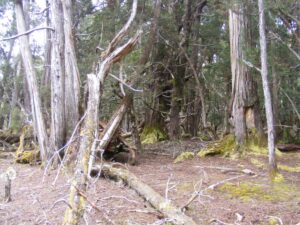
Meeting Basil Steers in 1979 was my introduction to high country snaring, which became, and remains, an abiding passion. We became better acquainted when I took legendary bush figure, HD “Dick” Reed on his return to The Paddocks after a 60-year break. Soon I became a frequent visitor to the Steers’ home at The Needles and numerous high-country trips ensued, mainly to the February Plains, the Pine Hut-The Paddocks area, but also to Dublin and Emu Plains.
The Wurragarra area remained unvisited country for some time for Basil & I until a 1983 trans-February Plains trip to Lake Ayr with Basil and Ron Morgan. Perhaps this and his Pelion Plains trip rekindled Basil’s personal and familial memories of snaring. Coincidentally, about the same time Basil showed me other hut sites: his 1946 Kings Plains hut, The Park and Harry Andrews’ hut. Another catalyst may have been the banning of snaring by the Gray Government in 1984. Whatever the reason, by November 1984 Basil had made the decision to build in the area so in preparation I “planted” some gear nearby.
Actual construction began in January 1985. Basil, his son Philip and myself commenced work. The hut, Steers No 3, was built in stages, and initially was just a basic frame with 2 trees for corner posts, (almost a signature of Basil’s huts) while the old hut nearby, McCoy No 1, provided rafters and palings. By year’s end after several trips Steers No 3 hut was almost complete with minor alterations and improvements, such as construction of bunks, a bench and a small porch for stacking firewood, occurring the following year. I, and sometimes Stewart Lowe, acted as “mules,” ferrying materials and gear across the February Plains from Steers No 2 hut and up the Arm River Track.
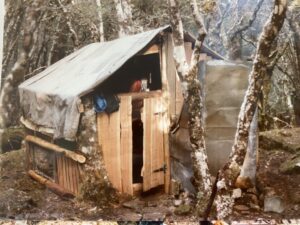
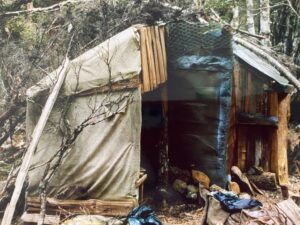
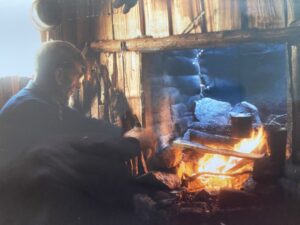
Basil only snared briefly in the area as emphysema gradually took hold and trips up the steep Arm River track became too arduous. Following its discovery in 1986, usage by outsiders increased and the relative isolation craved by Basil began to disappear. Still Basil remained active especially on a memorable snake encounter when he made “an incredible vertical backward leap as the snake reared up at him.” In November 1987 we investigated alternative hut sites around the Lake Steers area but none were suitable. This was to be Basil’s last trip into the Upper Wurragarra valley.
Despite this, Basil still visited his home country, the northern February Plains. After featuring in the initial ABC Big Country program, in June 1987 Colleen McCulloch’s Big Country Revisited team shot footage at Steers No 2 hut. Our trips together to this hut continued until 1993.
My 1990s visits to Steers No 3 hut, mainly to remove some personal items for Basil but also just to be there, elicited such responses in my walk notes as “it was good to be back home again” and “very pleased to be back again.” But after Basil’s death in 1997 visits petered out with my final trip in November of that year.
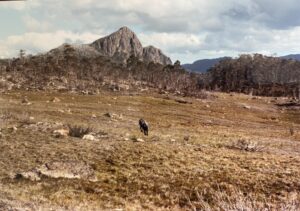
Over time the area had grown on me: visits were made in all weathers, from bracing windy days; fogs that seeped into your bones and made navigation difficult; sweltering hot days, especially out on the plains, and persistent drizzle which often turned into persistent soaking rain. The steep ascents, increasingly thick scrub in the valley north-west of Lake Price, challenging creek crossings after heavy rains and long sections across the Plains became etched into the mind. I missed the encompassing panoramic views, possibly the best in the high country, especially from The Divide and eastward and westward along the Wurragarra Valley to Mt Pillinger and mountains of The Reserve were favourites.
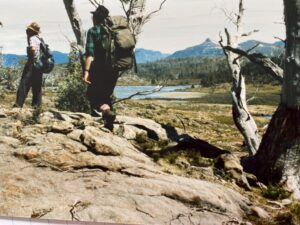
As I gradually began to know the country, there was an appreciation of the characters in the passing parade of history incorporating seasonal occupants ̶ aborigines, most probably bands of the Big River and North West tribes, stockmen and snarers, short-term occupants such as track workers and packers, and the more transient surveyors, photographers and bushwalkers. Research, encompassing archival and library visits and talking to high country snarers, was crucial. Thus, I learned about the pre-McCoy-Steers era. According to George Bott, the earliest-known snarers were Edgar Horton and Harry Glover from 1914, then from the 1920s Len Bonney, Percy Bellchambers, Basil and Cliff Scott, and, at some stage George and possibly Harry Clarke. After the Clarkes, from the 1940s, it was McCoy-Steers territory until the mid-1950s. Post Basil’s usage, the area became almost completely forgotten. Histories are always incomplete, mysteries abound and the Wurragarra account is no exception. Did Field’s stockmen build a shelter here? Why was the original hut built from eucalypts rather than pencil pine? What was the purpose of Clarke’s “rough shelter” in the pines? Did the big 1930s fire that swept the February Plains destroy the original hut? These are but some of the unresolved issues.
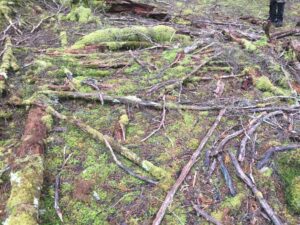
I was reminded that landscapes are constantly changing on my March homecoming with Peter Brown and Nic Haygarth. The open country from the Arm River Track to the hut had been replaced by thick scrub yet the Pencil Pines retained their grandeur. Although Mole Creek (Innes)Track landmarks such as stone fords across creeks and clearly defined track-sections and boulders were hidden, recollections of Basil and our shared past remained vivid. My homecoming joy was palpable as Peter wrote,
“For me the best part [of the trip] was seeing your face when you saw the pine forest and you had the biggest smile.”

Copyright Tim Jetson 2023
Tim is one of great historians of the Tasmanian high country. His interest and dedication to the people of this area wasn’t fashionable at a time when history focussed on the grand and rich. He published extensively and captured many stories that would have been otherwise lost. He has joined the Mountain Stories team on many searches all around the state and is a wonderful walking companion.
Great history and old stories,
Love this area and the central plateau.
Thanks Gary, it is a great location and Tim knows it well
Definitely one of my favourite huts. That location is awesome. Thanks for the story
lovely area and hut, visited it for the third time at xmas, it is looking good after the work done to the rafters etc
There are so many small bits of history in this small area it needs special safe gaurds.